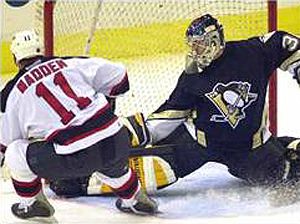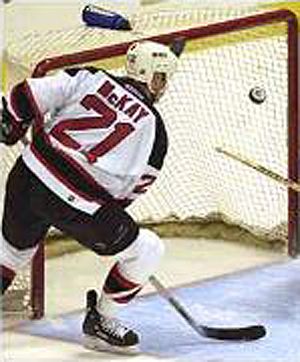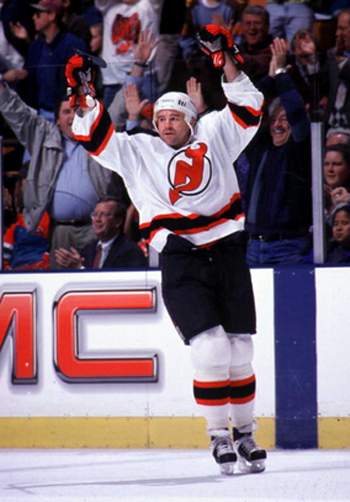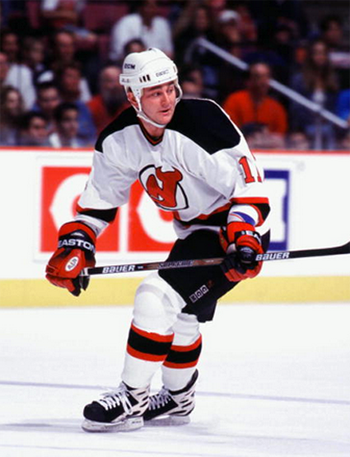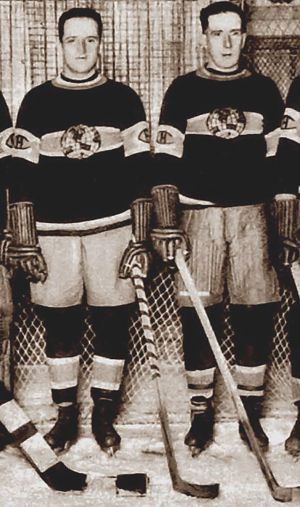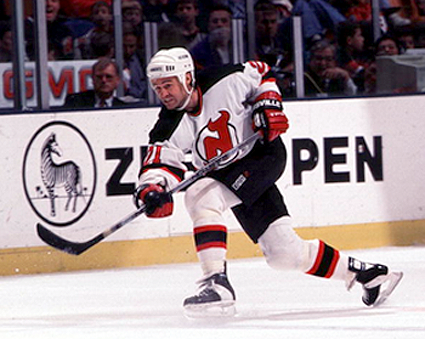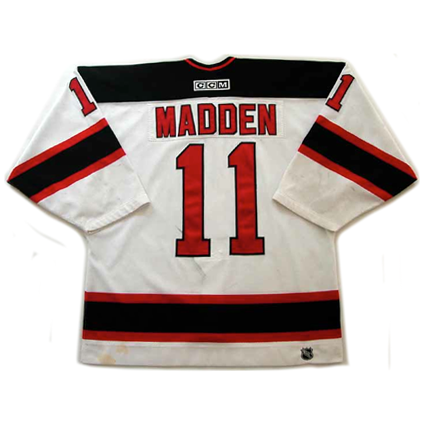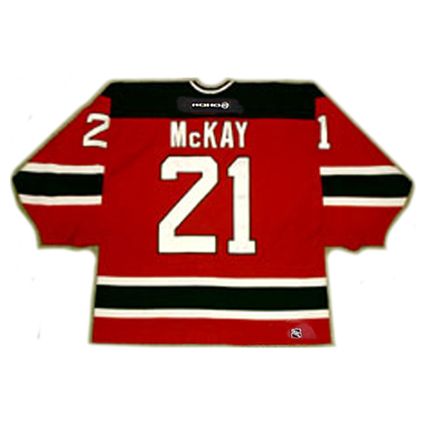Thursday, October 31, 2013
The Greatest Goalie Mask Ever
We are going to have a bit of a departure today and feature not a jersey, but a mask, which feels appropriate with today being Halloween.
Yes, tomorrow is the 50th Anniversary of Jacques Plante wearing the first full face goalie mask in an NHL game, so everyone on The Internets will be talking about his mask tomorrow, so we've decided to beat everyone to the punch by a day and talk about a different mask - worn by a very different individual.
In our opinion, the Third String Goalie Award for The Greatest Goalie Mask Ever goes to Gilles Gratton's mask from 1976 when he was with the New York Rangers - The Lion.
Or is it a Tiger?
It depends on who you ask. The guy who created it, or the guy who wore it!
Drafted 69th overall by the Buffalo Sabres of the NHL, Gratton began his professional career with the Ottawa Nationals of the WHA in 1972 and finished with an above .500 record (25-22-3) for a team that finished below .500. He would move with the franchise when they relocated to Toronto, and renamed the Toros, and post a 56-44-4 record over the next two seasons. Gratton was a member of Team Canada in the 1974 Summit Series which pitted the WHA All-Stars against the Soviet National Team.
The 1975-76 season would see him make his NHL debut for the St. Louis Blues, but only appear in 6 games after he left the team and attempted to rejoin the Toros.
It was in 1976 that Gratton would unleash The Greatest Goalie Mask Ever while playing for the New York Rangers.
Gratton, known as "Gratoony the Loony" for such things as refusing to play when the moon was in the wrong part of the sky and another time claiming pain from an injury he suffered as a solider in a previous life! Among the past lives he's claimed to have lived include a 15th century Spanish conquistador and a Mayan priest. Released by the Rangers, he quit hockey at the age of 24 and spent three years in India and the next 20 or so moving around Europe.
Gerry Cheevers is credited with starting mask decorating with his iconic "stitch marks" mask, but it was still essentially a plain white mask decorated with nothing more than a permanent marker. At the time Gratton came to the Rangers, masks were generally painted with simple designs, not usually more elaborate than stripes in team colors or designs based on elements of team logos.
Artist Greg Harrison's design skills began to become more bold and ornate, as evidenced by Gilles Meloche's Cleveland Barons "Coat of Arms" mask, Gary Simmons "Cobra" mask and Gary Bromley's frightening "Skull" mask, but the peak of the goalie masks was reached with Harrison's mask for Gratton in 1976.
Some say the mask is of a lion, including Harrison who designed the mask, but Gratton insists that it is a tiger. Either way, it was years ahead of it's time for 1976 and influenced many subsequent mask designs, such as Andy Moog's Bruins "Bear" mask, Curtis Joseph's "Cujo" mask and Brian Hayward's "Shark" mask. It was so revolutionary, so striking and so unlike anything else that had come before in it's realism that it even made Time Magazine on it's debut.
It's also one of the last of it's kind, as in 1977 Dave Dryden came to Harrison with the idea for the hybrid mask, a mask with a large facial opening covered by the wires from a cage. The combo mask would be perfected by 1979 and quickly became the standard, altering the canvas for mask painting forever by forcing the artists to work around the now gaping hole in the center.
Here is a nice documentary video on players from the WHA, which begins with Gratton and goes on to discuss many other players of the WHA, including of course the players who were the inspiration of the Hanson Brothers of the movie Slap Shot.
Bonus Jersey: You just knew that somehow, someway we were going to find an excuse to post a jersey today.
Today's Bonus Jersey is a 1974 Team Canada Gilles Gratton jersey from the second Summit Series between the WHA All-Stars and the Soviet National Team.
Similar to 1972 when Team Canada's jerseys all read "CANADA" on the back where you would normally find the player's name, in 1974, since players in the WHA were now being signed from Sweden and other European countries in addition to the Canadians and Americans, the jerseys for the WHA All-Stars in 1974 all had "INTERNATIONAL" across the back.
Labels:
Goalie Mask,
Gratton Gilles,
New York Rangers
Wednesday, October 30, 2013
1975-76 Boston Bruins Johnny Bucyk Jersey
Johnny Bucyk ranks as one of the most successful yet overlooked hockey players in NHL history.
He began his road to the NHL in 1951 when he joined the Edmonton Oil Kings of the Western Canadian Junior Hockey League for a single playoff game. He returned to the Oil Kings for the next two seasons, scoring 67 points in 33 games in 1954 and went on to win the prestigious Memorial Cup, before moving up to the Edmonton Flyers of the Western Hockey League for the 1954-55 season, scoring 30 goals and 88 points in 70 games.
Buyck while with the Edmonton Oil Kings
That performance earned Bucyk his chance to debut in the NHL with the Detroit Red Wings in 1955. Life in the NHL was not the same, as Bucyk competed in 38 games and managed just a single goal and eight assists for nine points. In his second season in Detroit he fared better, scoring 10 goals in 66 games.
A rare shot of Bucyk in a Red Wings jersey
That would prove to be the end of Bucyk's time in Detroit however, as he was traded to the Boston Bruins when the Red Wings reacquired goaltender Terry Sawchuk, whom they had dealt to Boston just two years prior.
His arrival in Boston back in 1957 would begin an affiliation with the organization that continues today, more than 50 years later. While it looked at first that Bucyk had arrived in Boston at a good time, evidenced by going to the Stanley Cup Finals in his first season in Boston, things would quickly turn sour for the club following a first round elimination in the 1959 playoffs, as the Bruins would spend the majority of the 1960's out of the playoffs, missing the postseason eight consecutive years, five of which were as the league's doormat buried in last place waiting for the arrival of Bobby Orr and Phil Esposito.
An early Bucyk hockey card following his trade to Boston
Still, Bucyk's personal numbers were incredibly consistent throughout, as eight of his ten seasons were between 52 and 66 points. During that period, Bucyk, a big player for his era a 6', 215 lbs., led the Bruins in scoring in 1962, 1963, 1965 and 1967, a season in which he was team captain.
1966-67 was also the season that the Bruins would begin to climb out of the depths with the arrival of Orr, followed by Esposito the following season. Bucyk would never again lead the Bruins in scoring, but the arrival of Orr and Esposito would ignite a scoring revolution that would propel Bucyk to personal bests never before imagined.
In a hilarious photo, Johnny Bucyk poses with goaltender Eddie Johnston and Bobby Orr as they pose with pucks indicating their career goal totals, Bucyk having just reached 300, Johnston still stuck at zero and Orr at 78!
Esposito's first season with Boston saw Bucyk reach 30 goals for the first time ever and eclipse his personal best season total with 69 points as the Bruins returned to the playoffs for the first time since the 1950s. Two seasons later he would equal the 69 points, but raise his goal total to 31. During the postseason, 11 more goals would follow as Bucyk scored 19 points in 14 games as the Bruins won their first Stanley Cup in 29 years. As the Bruins had no captain from 1967 to 1973, Bucyk, as the assistant captain with the greatest seniority, was the first to hoist the cup during the championship celebration.
Bucyk raises the 1970 Stanley Cup
1970-71 was a memorable one for Bucyk, as he would join the exclusive ranks of the 50 goal scorers, as he became the only the fifth player to accomplish the feat, only to be overshadowed by teammate Esposito's record shattering 76 that same season. Bucyk added 65 assists to surpass the 100 point mark for the only time in his career with 116 as Bruins Esposito (152), Orr (139), Bucyk and Ken Hodge (105) finished 1-2-3-4 in league scoring! When it came time to hand out the hardware at the conclusion of the season, Bucyk was named the recipient of the Lady Byng Trophy thanks to his season total of a mere 8 penalty minutes in 78 games.
This card commemorates Bucyk's first Lady Byng Trophy
Although his personal point totals were all down somewhat, his 83 points were still his second best season to date, his 20 points in 15 playoff games were key to the Bruins capturing the second Stanley Cup of Bucyk's career in 1972.
His offensive numbers would rise once more in 1972-73 when Bucyk scored 40 goals for only the second time in his career and his 53 assists propelled him to a 93 point season, including scoring his 1,000th career point, only the seventh player to reach that illustrious total.
He was again named team captain of the Bruins in 1973, a position he would hold until 1977. Following his 116 point season in 1971, Bucyk was a very consistent, productive player, averaging 83 points per season, and never below 75. 1973-74 saw the Bruins again return to the Stanley Cup Finals and Bucyk collect the second Lady Byng Trophy of his career after again finishing with just 9 penalty minutes. Amazingly, Bucyk was not awarded the Lady Byng in 1972, a season in which he was penalized a total of just 4 minutes, a mark equalled by the winner Jean Ratelle.
"I played physical but clean hockey," said Bucyk. "Most people think that the only reason a player wins the Lady Byng is because he is gentlemanly, but I had the ability to play physical and not draw penalties. I contributed offensively and stayed out of the penalty box."
On this date in 1975, Bucyk would again join an exclusive club when he became only the seventh player to reach 500 career goals, a tribute to his longevity, as he reached the 500 goal plateau in his 1,370th game. Of the 41 players to date to reach 500 goals, only Ron Francis would anyone require more games than Bucyk with 1533. Bucyk scored 20 goals or more in 16 of his 23 seasons.
Bucyk celebrates his 500th goal
He would play two more seasons before retiring at the age of 42 due to chronic back problems as the Bruins all-time leader in goals (556), assists (813) and points (1,369) as well as career games with 1,540. He was also the fourth leading scorer of all-time as well as the leading scorer among left wings and third in games played at the of his retirement.
The Bruins retired his #9 in 1980 and he became a member of the Hockey Hall of Fame in 1981.
"Having my Number 9 retired at the Boston Garden in 1980 was outstanding. It’s very exciting to see your number hanging there along with all the other great players. It’s the greatest honour a player can get."
Today's featured jersey is a 1975-76 Boston Bruins Johnny Bucyk jersey, as worn the season Bucyk joined the 500 goal club.
What sets this Bruins jersey apart is the lack of not only the colored shoulders of the previous style, discontinued for the 1974-75 season, but also the lack of the bear head shoulder patches, which would arrive for the following 1976-77 campaign and would remain in place all the way through the 1994-95 season. Names on the back would not arrive until the 1977-78 season.
All of that adds up to today's featured jersey variation of completely blank shoulders only being used for just two seasons, 1974-75 and 1975-76, the season of Bucyk's 500th goal.
All of that adds up to today's featured jersey variation of completely blank shoulders only being used for just two seasons, 1974-75 and 1975-76, the season of Bucyk's 500th goal.
Today's video segment begins with Johnny Bucyk Night in Boston, when the celebrate his 50 years with the organization.
Here, Bucyk scores a goal on February 25, 1971, igniting a Bruins outburst that results in the three fastest goals in NHL history at just a lightning fast 20 seconds!
Finally, a profile of Bucyk from the excellent Legends of Hockey series.
Labels:
Boston Bruins,
Bucyk Johnny
Tuesday, October 29, 2013
1939 NHL All-Star Eddie Shore Jersey
Prior to the NHL All-Star Game being an annual affair, which began with the first annual game in 1947, three previous benefit games took place featuring a team of NHL All-Stars on one side of the contest.
The third and final of those benefit games took place on this date in 1939 in memory of Babe Siebert, a former NHL player who had recently been named head coach of the Montreal Canadiens who drowned in Lake Huron while swimming before he began his new job as coach.
Babe Siebert from his playing days with the Montreal Maroons
To benefit his family, a game was organized by the Montreal Canadiens and Montreal Maroons, both of whom Siebert had played for during his career.
Held in the Montreal Forum, 6,000 fans attended the game between the Montreal Canadiens and a team of NHL All-Stars, raising $15,000 for Siebert's family.
Syl Apps, of the Toronto Maple Leafs, scored four points, one goal and three assists, in a 5-2 win for the All-Stars over the defending Stanley Cup champion Canadiens.
Siebert as a Montreal Canadien
Held in the Montreal Forum, 6,000 fans attended the game between the Montreal Canadiens and a team of NHL All-Stars, raising $15,000 for Siebert's family.
The program from the Babe Siebert Memorial Game
Syl Apps, of the Toronto Maple Leafs, scored four points, one goal and three assists, in a 5-2 win for the All-Stars over the defending Stanley Cup champion Canadiens.
"Busher" Jackson and Eddie Shore were named to the All-Star team, the only two players to appear in all three of the Benefit Era games, as well as referee King Clancy, who had participated in the first two benefit games as a player.
The All-Stars got on the board first with a pair of goals in the first period, first by Bobby Bauer from Apps and Johnny Gottselig at 8:30 followed by Shore for the All-Stars at 10:07, also from Apps and Gottselig.
Apps got his goal at 2:05 of the second from Bauer before Montreal got on the board when Earl Robinson scored on an assist from George Mantha and Ray Getliffe at 5:49.
The All-Stars get that one back two minutes later when Gottselig scored at 7:49 from Apps and Art Coultier and widened their lead to 5-1 when Earl Seibert (note the different spelling from Siebert) scored an unassisted goal at 11:21. Louis Trudel closed out the scoring at 19:15 of the second period when he scored on the All-Stars Frank Brimsek from Polly Druin and Rod Lorrain, as there was no scoring in the third period. Wilf Cude took the loss in goal for the Canadiens. Gottselig would finish the game with a goal and two assits.
Today's featured jersey is a 1939 NHL All-Star Eddie Shore jersey as worn in the Siebert Memorial Game on this date in 1939. This wool sweater was used just the single time during the All-Star contest and has survived in immaculate condition. Shore left it behind in his locker in New York after retiring while a member of the New York Americans after spending the majority of his career with the Boston Bruins.
Bonus jersey: Today's bonus jersey is a 1937 Montreal All-Stars Babe Siebert jersey as worn in the 1937 Howie Morenz Memorial game just two years prior to the Babe Siebert Memorial Game.
The Morenz game featured a team of NHL All-Stars taking on a team comprised of All-Stars from the Montreal Canadiens and Montreal Maroons following Morenz's death following a severely broken leg suffered during a game and a subsequent heart attack while still hospitalized for the broken leg.
Labels:
NHL All-Star Game,
Shore Eddie,
Siebert Babe
Monday, October 28, 2013
2000-01 New Jersey Devils John Madden Jersey
On this date in 2000, the New Jersey Devils traveled to Pittsburgh to take on the Penguins. It was the Devils 9th game of the season and they brought a 5-2-1 record into the game as well as a three game winning streak. Pittsburgh, meanwhile, stood at 5-3-1 after starting their season with a pair of games in Tokyo, Japan, tied with the Devils with 11 points atop the Atlantic Division.
Turner Stevenson got the scoring started with with a goal from Sergei Nemchinov and John Madden at 2:02 of the first period to put the Devils up by one.
The same line struck again at 4:45, this time with Madden scoring from Nemchinov and Stevenson. Randy McKay put the Devils up by three when he scored on the power play at 12:32 from Bobby Holik and Colin White at 11:18. Before the period ended, McKay scored his second off a goal post from Ken Sutton and Holik at 19:30 to send the Devils into the locker room with a stout 4-0 lead.
The second period began with Garth Snow taking over in goal for Pittsburgh and he held the Devils off the scoreboard for half a period until Madden scored his second at 11:10 on Nemchinov's third assist. The rout was on when McKay completed his hat trick at 12:32 from Brian Rafalski. It was the third hat trick of his career.
McKay completes his hat trick
Five minutes would pass before McKay scored his fourth of the night on a rebound off the back boards on a shot from Patrik Elias with the second assist from Rafalski at 17:44 before Madden made good in his bid for his first career hat trick with assists from Stevenson and Sutton at 18:57, putting the Devils out of reach at the end of 40 minutes 8-0.
Clearly owning the hot hand, their teammates kept feeding McKay and Madden the puck in the third period and Madden converted from a bad angle with assists from Ed Ward and Jim McKenzie for his fourth goal of the night at 15:55 of the third period to tie New Jersey's largest margin of victory ever at 9, accomplished twice before.
When Madden scored his fourth goal, he and McKay became the first teammates to score four goals in a game since Odie and Sprague Cleghorn did it for the Montreal Canadiens way back on January 14, 1922, a gap of over 78 years.
Odie and Sprague Cleghorn during their final season in
Montreal wearing their 1924-25 World's Champions sweaters
Montreal wearing their 1924-25 World's Champions sweaters
Madden and MaKay's four goals in a game also tied a team record held by Pat Verbeek since February 28, 1988.
Lost in the offensive fireworks was Broduer's shutout on 21 saves and McKay nearly stole the spotlight from Madden when he hit the pipe in the third period, just missing his fifth goal of the night.
McKay was named as The First Star of the Game despite Madden having five points in the game. "Randy's goals were much more fashionable than mine, so I'm sure they gave it to him for that even though I had one more point than he did." Madden needled after the game.
McKay was the first star of the game despite
being outscored by Madden
"I was in the right spot in the right time tonight, and it seemed like every time I got in the open, someone got me the puck," McKay said. "It was one of those nights where every time I touched the puck, I felt I had a shot. The last one, it came back to me, flat as could be, right in my wheelhouse and I had an open net to shoot at. Every time I came back to the bench, Bobby Holik was shaking his head. He couldn't believe it."
Holik concurred, "That's because he didn't just get goals, he got pretty goals, three of them. I was like, 'whooooo'. They weren't just going in, the goalie had no chance on them. It was hard to believe."
The reason for the extra celebration and incredulous reaction was that McKay was not known as much of a goal scorer and generally was a member of the Devils "Crash Line" of checkers and grinders. In his nine previous season in New Jersey, he averaged 12 goals a season with a career high of 24. After his four goal outburst, McKay would score just 16 goals in the Devils 73 remaining games.
"I scored one, I was happy with one," Madden Said. "The puck was coming my way."
"I would like to say I'm sorry to the people who bought tickets," Penguins coach Ivan Hlinka said. "I would like to say thanks to the people who stayed to the finish. I believe we ware not a bad team like tonight. I hope we will show our face over the next game and the next week."
Penguins defenseman Bob Boughner went farther, saying, "Maybe we should all take money out of our next checks and pay all the fans who stayed to watch the rest of that game. It's a joke."
This game was played back in the era when the home team traditionally wore white jerseys, but with the increasing number of colored alternate jerseys now in use, the visiting teams often had to wear white on the road to accommodate the home teams wearing their third jerseys, as was the case in the game where Madden and McKay each scored four goals, as Pittsburgh had just reintroduced the skating penguin logo on their new alternate jerseys in 2000-01.
In order to eliminate the need for the road teams equipment managers to have to pack two sets of jerseys for road trips, the rule was changed for the 2003-04 season onwards, where the road team would nearly always wear white, regardless of the home team was wearing their dark home jersey or colored alternates. There are of course always exceptions to this rule, but in general it made life easier for the traveling equipment managers league wide.
Today's Bonus jersey is a 2000-01 New Jersey Devils Randy McKay jersey. The Devils jersey is on it's way to joining the Canadiens, Red Wings and Blackhawks as one of the longest tenured iconic jerseys in the NHL, as team president Lou Lamoriello steadfastly remains against any changes to the Devils jersey adopted in 1992, including the adoption of an alternate jersey for the Devils.
Today's video segment begins with a McKay overtime game winner in the 1995 playoffs, in what was until then a scoreless tie against the Boston Bruins.
In this next clip, Madden seals a win over Patrick Roy and the Colorado Avalanche in the 2001 Stanley Cup playoffs.
Labels:
Madden John,
McKay Randy,
New Jersey Devils
Subscribe to:
Comments (Atom)
